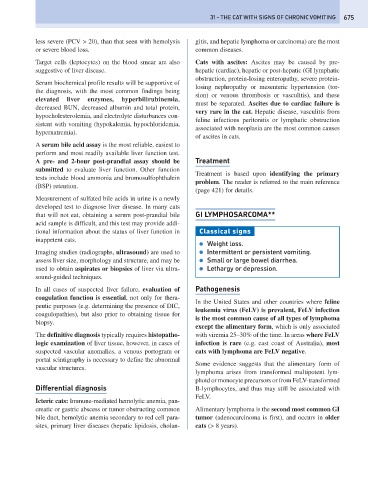Page 683 - Problem-Based Feline Medicine
P. 683
31 – THE CAT WITH SIGNS OF CHRONIC VOMITING 675
less severe (PCV > 20), than that seen with hemolysis gitis, and hepatic lymphoma or carcinoma) are the most
or severe blood loss. common diseases.
Target cells (leptocytes) on the blood smear are also Cats with ascites: Ascites may be caused by pre-
suggestive of liver disease. hepatic (cardiac), hepatic or post-hepatic (GI lymphatic
obstruction, protein-losing enteropathy, severe protein-
Serum biochemical profile results will be supportive of
losing nephropathy or mesenteric hypertension (tor-
the diagnosis, with the most common findings being
sion) or venous thrombosis or vasculitis), and these
elevated liver enzymes, hyperbilirubinemia,
must be separated. Ascites due to cardiac failure is
decreased BUN, decreased albumin and total protein,
very rare in the cat. Hepatic disease, vasculitis from
hypocholesterolemia, and electrolyte disturbances con-
feline infectious peritonitis or lymphatic obstruction
sistent with vomiting (hypokalemia, hypochloridemia,
associated with neoplasia are the most common causes
hypernatremia).
of ascites in cats.
A serum bile acid assay is the most reliable, easiest to
perform and most readily available liver function test.
A pre- and 2-hour post-prandial assay should be Treatment
submitted to evaluate liver function. Other function
Treatment is based upon identifying the primary
tests include blood ammonia and bromosulfophthalein
problem. The reader is referred to the main reference
(BSP) retention.
(page 421) for details.
Measurement of sulfated bile acids in urine is a newly
developed test to diagnose liver disease. In many cats
that will not eat, obtaining a serum post-prandial bile GI LYMPHOSARCOMA**
acid sample is difficult, and this test may provide addi-
tional information about the status of liver function in Classical signs
inappetent cats.
● Weight loss.
Imaging studies (radiographs, ultrasound) are used to ● Intermittent or persistent vomiting.
assess liver size, morphology and structure, and may be ● Small or large bowel diarrhea.
used to obtain aspirates or biopsies of liver via ultra- ● Lethargy or depression.
sound-guided techniques.
In all cases of suspected liver failure, evaluation of Pathogenesis
coagulation function is essential, not only for thera-
In the United States and other countries where feline
peutic purposes (e.g. determining the presence of DIC,
leukemia virus (FeLV) is prevalent, FeLV infection
coagulopathies), but also prior to obtaining tissue for
is the most common cause of all types of lymphoma
biopsy.
except the alimentary form, which is only associated
The definitive diagnosis typically requires histopatho- with viremia 25–30% of the time. In areas where FeLV
logic examination of liver tissue, however, in cases of infection is rare (e.g. east coast of Australia), most
suspected vascular anomalies, a venous portogram or cats with lymphoma are FeLV negative.
portal scintigraphy is necessary to define the abnormal
Some evidence suggests that the alimentary form of
vascular structures.
lymphoma arises from transformed multipotent lym-
phoid or monocyte precursors or from FeLV-transformed
Differential diagnosis B-lymphocytes, and thus may still be associated with
FeLV.
Icteric cats: Immune-mediated hemolytic anemia, pan-
creatic or gastric abscess or tumor obstructing common Alimentary lymphoma is the second most common GI
bile duct, hemolytic anemia secondary to red cell para- tumor (adenocarcinoma is first), and occurs in older
sites, primary liver diseases (hepatic lipidosis, cholan- cats (> 8 years).

